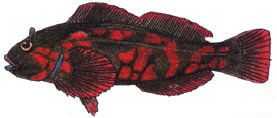Rock Greenling

Species Details
Hexagrammos Lagocephalus
Hexagrammidae
Scorpaeniformes
Reefs, inshore
1 - 2 lbs.
21" - 24"
Rock Greenling (Hexagrammos lagocephalus) Fish Description
Rock Greenling, also known under the name Fringed greenling, sea trout, kelp trout and confused as the Red Rock Trout, is greenish-brown, or maroon colored fish with darker mottling. The majority of Rock Greenling fish have blue spottings that fade to bright red on their sides. They also have dark bars and blotches on their fins and have blue mouths. Juvenile Rock Greenlings are known to have bright red eyes.
Diet & Size
Rock Greenling have a generalized diet, as they can eat just about everything from invertebrates, like crabs and isopods, to fish eggs, and algae. Young Rock Greenlings, however, eat zooplankton. They can grow up to the length of 24 in. and rarely weigh more than 2 lbs.
Interesting Facts about Rock Greenling
- Most Rock Greenlings are averse to human interaction, but recently a diver videographer from Hakai Institute was able to capture the beautiful fish, who would say it to be a top contender for one of the most colorful fish in [British Columbia] waters, with its distinctive patterns and blue and bright red spots on its sides and fins.
- Their unique colorful pattern helps the Rock Greenling camouflage in their natural environment.
- Females, who occupy deeper depths of water in comparison to males, move inshore for spawning from January to March. During the incubation period, the Males would guard the eggs, which are laid in rock crevices with notably strong currents. Once spawned, the young settle in open sand and as they age to move to more complex habitat such as kelp beds and offshore rocky reefs.
- Not only valued as game fish, but they are also considered to be valued food, for their mild-flavour and suitability for most forms of cooking.
- Rock Greenling can live up to the age of 11 years.
Fishing Techniques
Rock Greenling are commonly found inhabiting subtidal algae beds and rocky reefs ranging from the Bering Sea to southern California. Anglers most frequently catch these game fish off of exposed rocky shores, or shallow rocky areas, so if you’re wanting to catch one of these fish best to take their advice on looking for places like those during the morning or so because Rock Greenling are known to be daytime feeders.
When choosing a hook for the Rock Greenling, since these fish have relatively small mouths, its best to go for smaller hooks, about a #4 or #6. And for bait, considering they have quite a common diet, baits such as cut slices of fish, clams, mussels, shrimps, worms, crab backs and squid would do the trick. You can even try feathered jigs topped off with some squid for better results.
Rock Greenlings could be quite a challenge to land, as you can expect once you’ve hooked one up, they have a habit of entangling your lines in the rocks and kelp.
Habitat and Distribution
Rock Greenlings are commonly a solitary species but are not aggressive. They can come off quite cryptic and elusive to divers and spearfishermen, considering their preference to live alone among the rocks with heavy surges, but sometimes they can be found in tidepools and sandy areas.
Rock Greenling’s distribution can range along the Pacific Coast of Alaska’s Bering Sea up to southern California. And some reported the northern areas of the Sea of Japan, Hokkaido, and the Sea of Okhotsk







